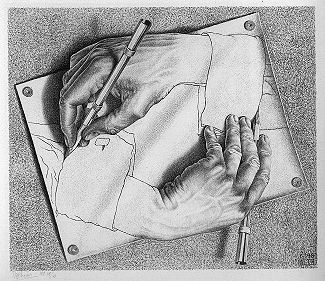The moment we invented us, we knew we were going to create literature of the first
magnitude. The part of us called the author and the part called the editor
alternated harmoniously to develop a short story. When this had taken shape, we
felt obliged to co-create a reader also. Not any reader, not any particular
reader, but a generic entity, without trace of gender identity, personality or
ideological bias.
Now a trinity, we functioned smoothly and ideally (since we didn't wish to imagine
any problems). In fact, problems were solved without ever arising. For
instance, our fiction was the greenest shade of environmentalism, requiring no
actual paper, nor energy to run printing presses or whatever. All was safely
contained in the realm of imagination, where processes of construction and
deconstruction cycled softly, like a top-of-the-line washing machine on its
most gentle setting.
A point was reached when, unanimously, the work was judged complete. All that remained was
to generate a suitably post-modern title.
Unexpected, a conflict arises. The imagined author disagrees with the imagined editor.
Being unbiased, the imagined reader is, and must be, undecided. So the writing
process stalls just short of delivering product. Like a shadow, each argument
of one side is balanced by an equal and opposite one from the other. Only what
is darkness and what is light? Where shadow, where deconstructed substance?
The strange loop of author imagining a disagreeing editor who imagines a disagreeing author
(but not in any particular order), becomes stranger. Weighed down by the solid
burden of internal contradiction, the loop sags like a collapsing virtual
Moebius strip. Like a car revving in neutral, the creative process cannot proceed.
This is why the story you are reading was neither published, written, nor titled. You didn't
even imagine it. Please forget it immediately.
Tad Boniecki

